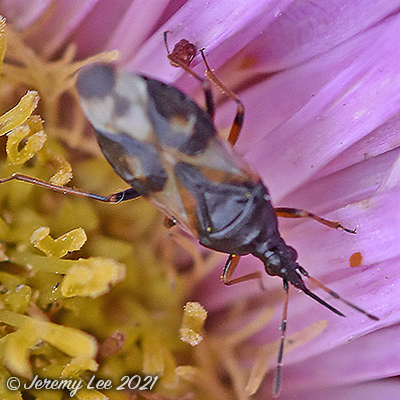
 |
|
Scientific Classifications explained » Amphibians » Ants » Aphids » Bees » Beetles » Birds » Bugs » Butterflies » Caterpillars » Damselflies » Dragonflies » Earwigs » Flies » Frog/Leafhoppers » Fungi » Galls » Grasshoppers » Harvestmen » Hoverflies » Lacewings » Ladybirds » Leaf Mines » Lichens » Mammals » Millipedes » Mosses » Moths » Sawflies » Slugs » Snails » Spiders » Trees & Shrubs » Wasps » Wild Flowers » Woodlice » Postboxes |
UK Nature > Bugs > Anthocoris nemorum

Scientific Name: Anthocoris nemorum Common Name: Common Flower Bug Anthocoris nemorum, more commonly known as the Common Flower Bug, is probably the most common species of this difficult genus. The forewings are entirely reflective, and the pronotum entirely black. The legs are mostly orange-brown, with variable development of small dark patches near the tip of the femora, especially on the hind leg. The antennae are largely pale in the 2nd and 3rd segments, with dark tips to the segments, and dark 1st and 4th segments (how reliable this is we cannot yet be certain). The dark patch on the membrane is typically hourglass-shaped. The species is predatory, and found on almost any plants, but preferring lower vegetation to trees. Abundant across the UK. Normally 3-4 mm in length, it exists as an adult all year round. |
|

https://www.uknature.co.uk is a website dedicated to showing the immense diversity of UK nature and wildlife. Our vast range of habitats, from lowland arable to snow covered mountains, from storm-ravaged coastlines to peaceful inland freshwater lakes and rivers, from dry, sandy heaths to deciduous and coniferous forests, all these habitats contribute to the abundance of UK nature. We have wild birds in huge numbers either residing or visiting our shores (597 recorded species as at July 2013) and we must also not forget the humble back garden with its grass lawns, flower beds filled with nectar rich flowers, shrubs and trees, all designed to attract huge numbers of insects such as bees, moths, butterflies and hoverflies; and finally the small ponds which provide safe havens for frogs, toads, newts and even slow worms and grass snakes. www.uknature.co.uk is the showcase for my personal passion, photographing uknature in all its glory. I sincerely hope you all enjoy the fruits of my labours. This site and all images contained therein is © Jeremy Lee 2004 - 2025. All Rights Reserved. Site design by Jeremy Lee. Site development & IT Support by Stuart Lee. |